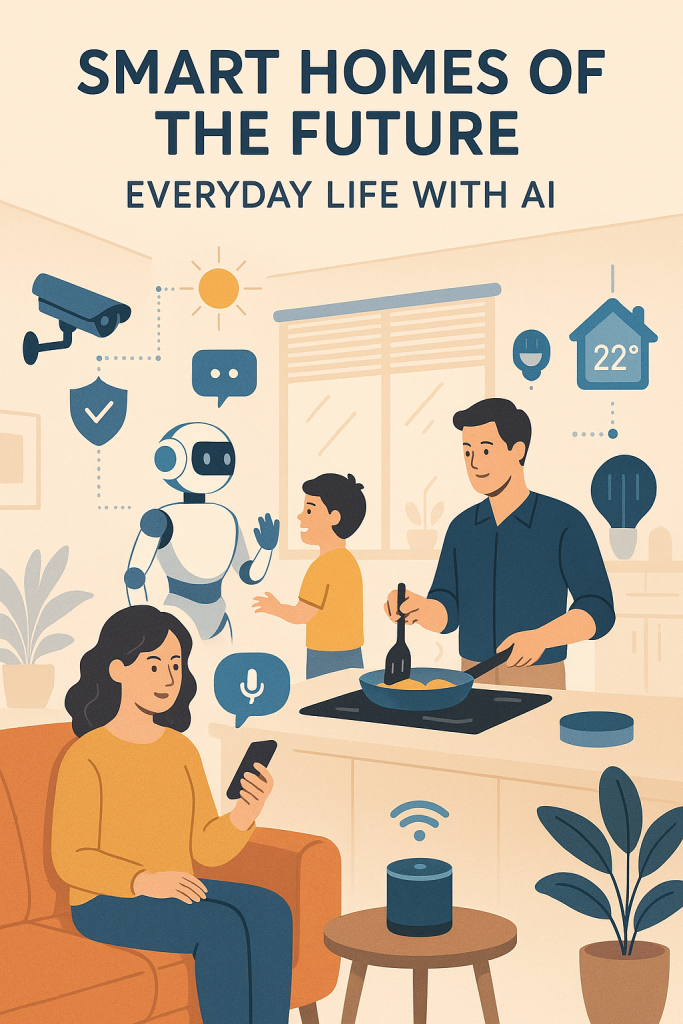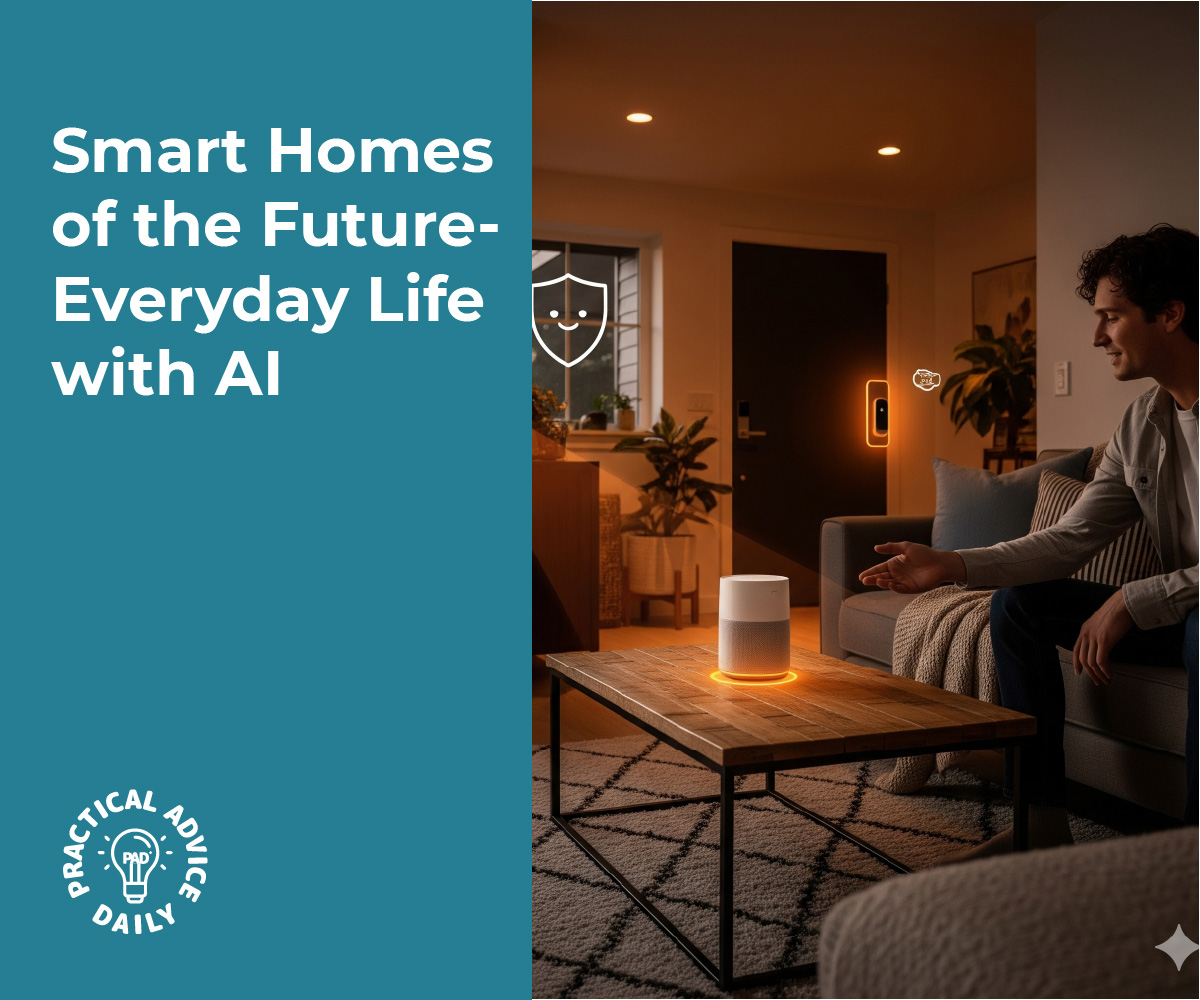Imagine waking up to the smell of fresh coffee, lights gently turning on, and a friendly voice reminding you of today’s appointments—all without you lifting a finger. This is no longer a futuristic dream. With the help of AI-powered smart devices like Alexa, Google Home, smart refrigerators, and advanced security systems, many households are already enjoying a new level of comfort and safety.
If technology sometimes feels overwhelming, don’t worry. This guide is written in simple terms to help you understand what a “smart home” really means and how these tools can fit into your everyday routine. We’ll also give you practical, step-by-step tips you can try at home.
Table of Contents
Key Takeaways
- AI voice assistants like Alexa and Google Home act as central hubs to control lights, music, reminders, and more.
- Smart appliances make daily chores easier, from ovens that preheat themselves to fridges that suggest recipes.
- Security systems powered by AI can detect unusual activity, notify you instantly, and keep your family safe.
- Smart homes are not just about gadgets—they are about saving time, reducing stress, and increasing peace of mind.
- You can start small with one device and gradually build up a system that suits your needs.
How AI Fits Into Daily Home Life
1. Voice Assistants: Your Personal Helper
Devices like Amazon Alexa and Google Home respond to simple voice commands. You can ask them to:
- Play your favorite music
- Read out the news or weather
- Remind you to take medication
- Turn off the lights without leaving the couch
They also connect to other smart devices, so with one request, you can set the thermostat, lock the doors, or even start the coffee maker.
Try It Yourself:
- Buy a basic voice assistant (Amazon Echo Dot or Google Nest Mini are affordable starters).
- Plug it in and connect it to your Wi-Fi using the free app on your phone.
- Try saying, “What’s the weather today?” or “Set a timer for 10 minutes.”
- Explore skills like playing music, creating shopping lists, or controlling smart plugs.
Real-life example: Imagine your hands are full while cooking. Instead of reaching for your phone, you simply say, “Alexa, set a timer for 20 minutes,” and it’s done.

2. Smart Appliances: Everyday Chores Made Easier
Appliances are becoming smarter and more interactive.
Examples include:
- Smart Refrigerators: Keep track of groceries and suggest recipes.
- Smart Ovens: Preheat themselves and adjust cooking times for better results.
- Robotic Vacuums: Clean on a schedule or whenever you ask.
These tools not only save time but can also reduce waste and help you stay organized.
Try It Yourself:
- Start with something simple like a robotic vacuum. Many affordable models connect to Wi-Fi.
- Download the companion app and schedule it to clean while you’re out.
- For cooking, some smart ovens let you scan food packaging with your phone to set the right temperature automatically.
Real-life example: Your fridge notices you’re low on milk and sends a reminder to your phone while you’re at the store.
3. Smart Security: Peace of Mind at Home and Away
One of the most valuable uses of AI in homes is security. Smart systems can:
- Send alerts when motion is detected
- Recognize familiar faces and ignore them, while alerting you about strangers
- Allow you to check live video from your phone anytime
- Lock doors automatically if you forget
Try It Yourself:
- Install a video doorbell such as Ring or Google Nest Hello.
- Connect it to your phone and test the live video feature.
- Enable motion alerts so you get a notification if someone approaches your door.
- If you feel comfortable, connect it with a smart lock to unlock doors remotely.
Real-life example: You’re on vacation, and your door camera notifies you of a package delivery. You can unlock the door for the courier and lock it again once they leave—all from your phone.
4. Safety and Accessibility for Older Adults
AI smart homes are especially helpful for older adults or anyone who may need extra support.
Some examples:
- Voice assistants can remind you to take medicine or attend an appointment.
- Smart lighting can automatically turn on at night to prevent falls.
- Emergency alerts can notify family members if something unusual happens.
Try It Yourself:
- Set a daily voice reminder: “Hey Google, remind me to take my medication at 8 a.m.”
- Add motion-sensor night lights in hallways or bathrooms.
- If you use a smart watch, connect it to your home system for fall detection alerts.
These features give both independence and peace of mind.
5. The Bigger Picture: Saving Energy and Money
AI-powered homes often come with energy-saving features:
- Smart thermostats learn your routines and adjust temperatures.
- Smart lights turn off when no one is in the room.
- Appliances can run during off-peak hours to lower bills.
Try It Yourself:
- Install a smart thermostat (like Nest or Ecobee).
- Use the app to set your preferred temperature schedule.
- After a week, the thermostat will begin adjusting automatically based on your habits.
- Track your energy usage in the app to see savings over time.
Real-life example: In summer, the thermostat lowers cooling while you’re at work and cools down the house just before you get home.
How to Start Building Your Own Smart Home
If the idea of connecting all these devices feels overwhelming, remember you don’t need to do everything at once.
Step 1: Pick a Hub
Choose either Alexa or Google Home as your main assistant. Both work with most devices, so you can expand later.
Step 2: Add One Device at a Time
Start small. A smart speaker, a light bulb, or a plug you can control with your voice is a great way to begin.
Step 3: Explore Routines
In the app, you can create routines like:
- “Good Morning” → turns on lights, tells you the weather, and plays the news.
- “Good Night” → locks the doors, lowers the thermostat, and plays calming music.
Step 4: Expand as Needed
Once you feel comfortable, add smart locks, cameras, or appliances. Each step makes your home more connected.
Beginner’s Smart Home Setup Checklist
Here’s a simple checklist you can follow or even print out:
✅ Choose your main hub (Alexa or Google Home)
✅ Set up your first smart speaker or display
✅ Connect to Wi-Fi and practice with simple voice commands
✅ Add one smart device (light bulb, plug, or switch)
✅ Try creating a routine (morning or bedtime)
✅ Add a security device (video doorbell or camera)
✅ Explore energy-saving tools like smart thermostats
✅ Gradually expand with appliances or additional devices
✅ Test everything and make sure family members know how to use it
Final Thoughts
Smart homes of the future are not about having flashy gadgets. They are about making everyday life simpler, safer, and more enjoyable. From voice assistants that answer your questions to security systems that keep an eye on your home, AI-powered devices can provide real peace of mind.
If you’re new to this technology, start small—maybe with a voice assistant or a smart light bulb—and see how it fits into your routine. Step by step, you can build a home that feels more supportive and connected.
Your home should be a place of comfort. With AI, that comfort is becoming smarter every day.
